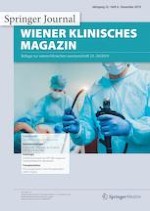08.11.2019 | Transplantationsmedizin | Transplantation
Aktuelle Aspekte der Immunsuppression nach Transplantation solider Organe
Erschienen in: Wiener klinisches Magazin | Ausgabe 6/2019
Einloggen, um Zugang zu erhaltenZusammenfassung
Hintergrund
Durch die Einführung potenter Immunsuppressiva hat sich die Transplantation solider Organe zu einem etablierten Verfahren bei terminalem Organversagen entwickelt. Durch das verbesserte Überleben umfassen die Ansprüche an eine moderne Immunsuppression sowohl die Verhinderung und Behandlung von Abstoßungsepisoden als auch die Minimierung von Langzeitkomplikationen der Immunsuppressiva.
Ziel der Arbeit
Aktuelle Aspekte der Immunsuppression nach Transplantation solider Organe sollen exemplarisch am Beispiel der Lebertransplantation erläutert werden.
Material und Methoden
Es erfolgte eine auf PubMed (U.S. National Library of Medicine, Bethesda, MD, USA) basierte Literaturrecherche hinsichtlich aktueller Studien und Analysen zur Immunsuppression nach Transplantation solider Organe mit besonderem Fokus auf die Immunsuppression nach Lebertransplantation.
Ergebnisse
Die Immunsuppression nach Transplantation solider Organe wird in eine Induktions- und Erhaltungstherapie unterteilt. Die Basis der Immunsuppression stellen Calcineurininhibitoren dar. Akute Abstoßungen sind in den ersten 3 Monaten nach Lebertransplantation am häufigsten, während im Langzeitverlauf Komplikationen der Immunsuppression die Prognose limitieren. Verschiedene Protokolle zur Minimierung der Calcineurininhibitorexposition sind verfügbar.
Diskussion
Ziel ist es heute, durch frühzeitige Reduktion der Immunsuppressiva bereits im ersten Jahr nach Transplantation das Risiko langfristiger Nebenwirkungen der immunsuppressiven Therapie zu minimieren. Die Möglichkeiten einer Individualisierung der Immunsuppression sind durch die limitierte Anzahl verfügbarer Medikamente begrenzt. Effektive Strategien zum Erreichen einer operationalen Toleranz sind mit den heute verfügbaren Medikamenten nicht etabliert.
Anzeige
